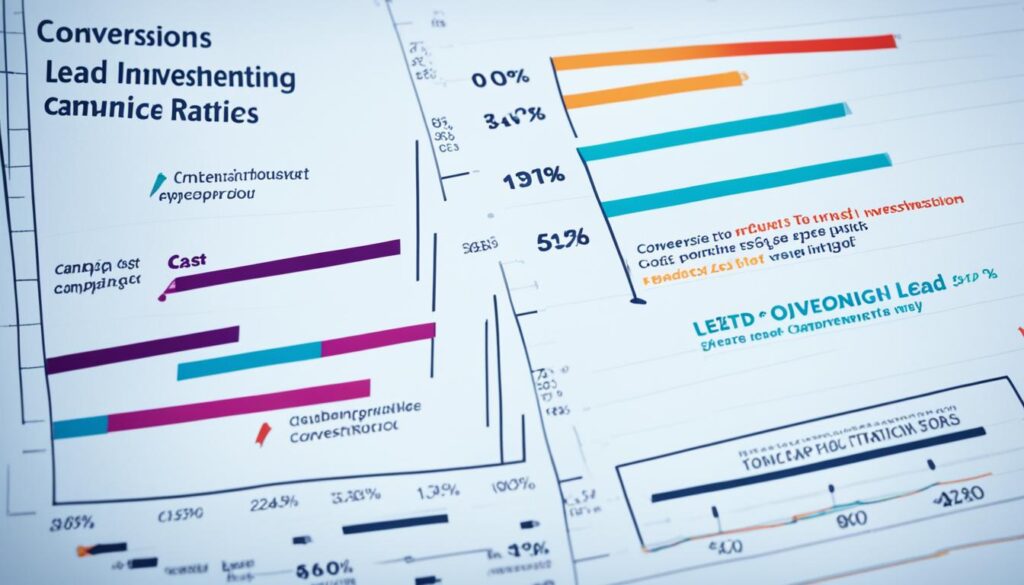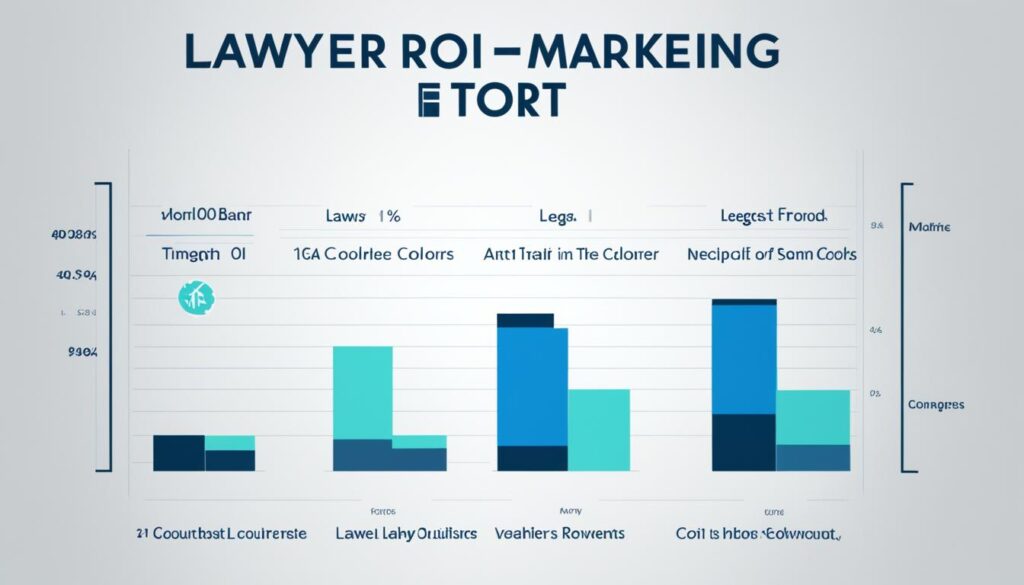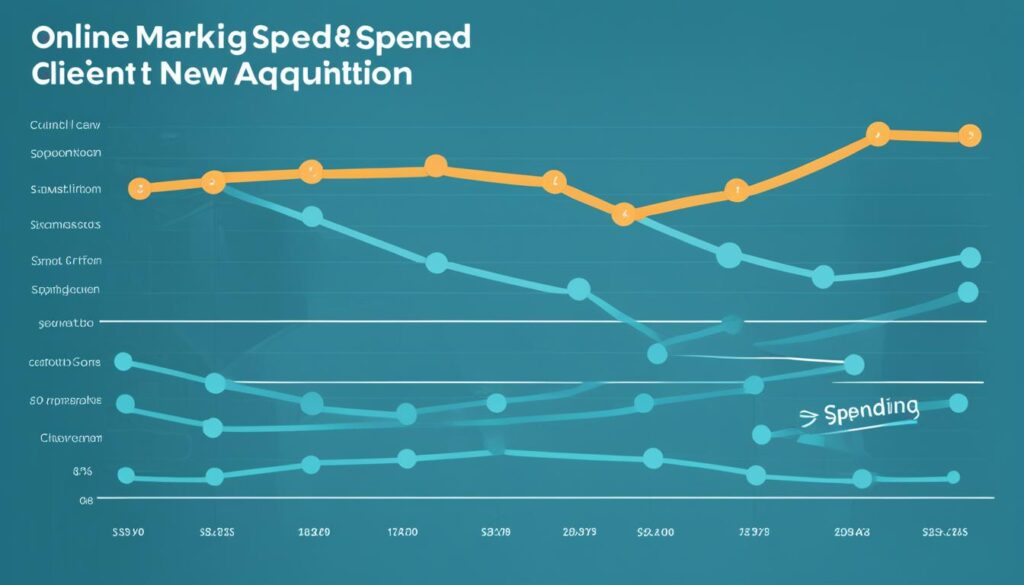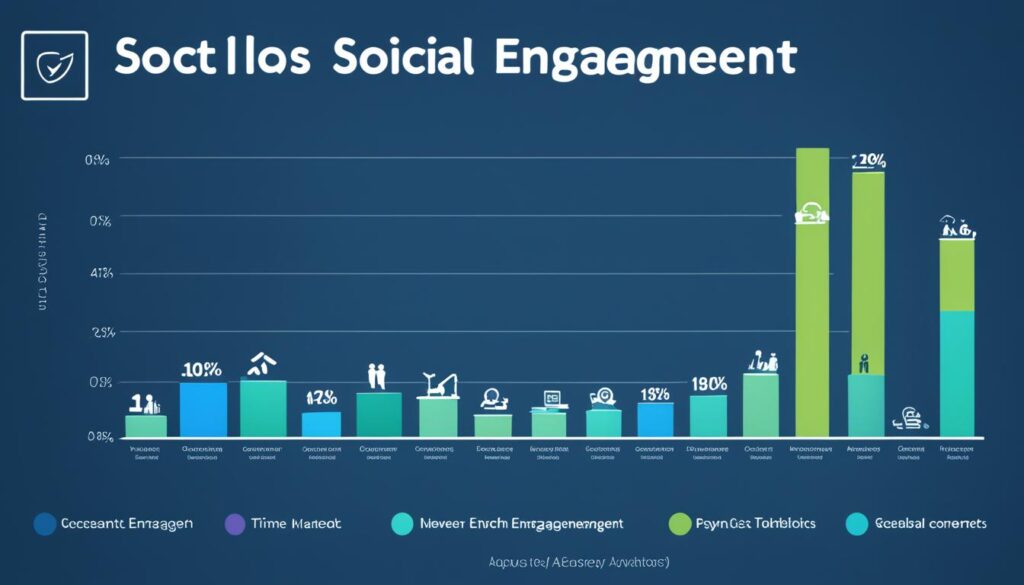Tracking marketing success is crucial for law firms. They need it to maximize their investment in marketing. By looking at the right metrics and using analytics, law firms can find out how well their marketing works. They can then use this data to make smart choices and use their resources better. We’ll look at important metrics and analytics lawyers should watch. These help them see how successful their marketing campaigns are and improve their marketing ROI.

Key Takeaways:
- Measuring ROI is crucial for law firms to assess the effectiveness of their marketing efforts.
- Tracking lead generation metrics provides insights into lead quality and conversion rates.
- Financial metrics like cost per lead and client lifetime value help evaluate the cost-effectiveness of marketing campaigns.
- Monitoring campaign-specific metrics such as content engagement and email marketing metrics helps assess the success of specific campaigns.
- Small law firms should focus on monitoring marketing KPIs to optimize their marketing initiatives.
Lead Generation Metrics
Generating leads is key for lawyers to find new clients. It’s crucial to keep track of certain metrics to see if efforts are paying off. These metrics offer insights on how well leads are being brought in and their quality. This helps law firms decide based on data.
Lead Volume
Lead volume shows how many people are interested in a law firm’s services. Tracking this over time lets law firms gauge their marketing success. This means seeing if their campaigns are drawing in potential clients effectively.
Lead Quality
It’s not just about how many leads, but their quality matters too. Lead quality looks at how likely it is to turn those leads into clients. By looking at how relevant and interested the leads are, firms can aim their efforts at the best prospects.
Conversion Rates
Conversion rates tell us how many leads actually become clients. These rates help law firms understand if their methods of turning leads into clients are working. It’s key in seeing how well their strategies are performing.
Lead Scoring
Lead scoring gives points to leads based on their actions or how engaged they are. This helps firms focus on leads that are more likely to become clients. It makes things more efficient and raises the chances of success.
Tracking metrics is vital in lawyer marketing. By monitoring lead volume, quality, conversion rates, and scoring, law firms can refine their methods. This leads to better use of resources and higher returns on investment.
Financial Metrics
Financial metrics are key when evaluating lawyer marketing efforts. They show how efficient and profitable these campaigns are. Law firms should keep an eye on three important metrics:
Cost per Lead (CPL)
The CPL metric measures the cost to get one lead. It shows if a law firm’s marketing strategies are working well. By knowing the CPL, firms can figure out which campaigns are most cost-effective.
This helps in growing the business. CPL shines a light on effective lead generation.
Customer Acquisition Cost (CAC)
CAC is about more than just getting a lead. It includes all costs of turning a lead into a client. This gives law firms a full picture of what a new client costs them.
By tracking CAC, firms can tweak their marketing. They aim to find clients at a good cost.
Client Lifetime Value (CLV)
Unlike CPL and CAC, CLV looks at expected revenue from a client over time. It shows the worth of chasing certain clients. With CLV, firms know where to put their resources.
They focus on clients who will bring in a lot of money. Monitoring these metrics helps firms make smart decisions. They can get the most out of their marketing budget.
Let’s look at an example to see how these metrics work together:
Example:
Law Firm XYZ spent $10,000 on marketing, getting 100 leads. So, the CPL was $100 per lead. Yet, only 20 leads became paying clients.
With a $10,000 spend for 20 clients, the CAC was $500 per client. This shows the cost to get each new client.
Looking at CLV, if each client brings $5,000, the firm could earn $100,000 from the 20 clients. This shows why getting clients at a good cost matters. It points to the value they add over time.
| Metric | Calculation | Result |
|---|---|---|
| Cost per Lead (CPL) | Total Cost / Number of Leads | $10,000 / 100 = $100 |
| Customer Acquisition Cost (CAC) | Total Cost / Number of Clients | $10,000 / 20 = $500 |
| Client Lifetime Value (CLV) | Expected Revenue per Client | $5,000 |
By understanding CPL, CAC, and CLV, law firms can make better choices. This improves their marketing and ups their profits.

Campaign Specific Metrics
To measure a marketing campaign’s success, focus on specific metrics. These provide deep insights into strategy effectiveness. Law firms can use these metrics to enhance their marketing and achieve better outcomes.
Content Engagement Metrics
Content engagement metrics gauge how content attracts and retains interest. They show if your content connects with your audience. And, they indicate if it sparks meaningful interactions.
- Page Views: This metric measures the number of times a specific content page has been viewed. It helps you understand the popularity and reach of your content.
- Time Spent on Page: The amount of time visitors spend on a content page indicates their level of engagement. If visitors spend a significant amount of time on a page, it suggests that they find the content informative and valuable.
- Actions Taken: Actions taken on your content, such as likes, comments, shares, and downloads, provide insights into the level of engagement and the impact your content has on your audience.
Email Marketing Metrics
Email marketing remains a powerful way for law firms to build client relationships and generate leads. Tracking email metrics helps improve engagement and conversion. It lets you make data-informed improvements.
- Open Rates: Open rates measure the percentage of recipients who open your emails. It reflects the effectiveness of your subject lines and the relevance of your email content.
- Click-Through Rates: Click-through rates indicate the percentage of recipients who clicked on links within your emails. It measures the level of engagement and the effectiveness of your call-to-actions.
- Unsubscribe Rates: Unsubscribe rates show the percentage of recipients who decided to opt-out of receiving further emails. Monitoring this metric helps you assess the relevance and quality of your email content.
Website Traffic and Behavior Metrics
Website traffic and behavior metrics reveal how marketing affects visitors. They help you see how users interact with your site. It’s key to identifying ways to improve user experience.
- Page Views: Similar to content engagement metrics, page views measure the number of times a specific page on your website has been viewed. It provides insights into the popularity and reach of your website content.
- Time Spent on Site: The average time visitors spend on your website is an indicator of their level of interest and engagement. The longer visitors stay on your site, the more likely they are to find value in your content.
- Actions Taken: Actions taken on your website, such as form submissions, downloads, and purchases, demonstrate the level of engagement and the effectiveness of your website in guiding visitors towards conversion.
Using campaign-specific metrics in your analytics toolkit helps understand your marketing’s effectiveness. Evaluating content engagement, email marketing, and website metrics lets you optimize campaigns for better results.

Importance of KPIs for Small Law Firms
Key performance indicators (KPIs) are vital for small law firms. They help check if marketing strategies work well. Small law firms must watch their spending closely. They need to make sure their marketing pays off.
By using KPIs, small law firms can see how their marketing affects their money flow. This helps them know which methods work best. Keeping an eye on KPIs helps firms make smart choices and improve their marketing.
“Investing in marketing without tracking KPIs is like driving blindfolded. You need to measure the success of your efforts to stay on the right path.”
The Role of KPIs in Marketing Effectiveness
Marketing effectiveness is how well a law firm reaches its marketing goals and makes good on its investment. KPIs act as markers to judge the success of marketing work. They help small law firms know how well they are doing in reaching and influencing their target audience.
Tracking key marketing KPIs gives small law firms insight into what’s working. They can spot trends and use their resources wisely. Keeping tabs on things like website visitors, lead generation, and how much clients cost provides useful info. This data helps shape smarter marketing plans.
“To thrive in a competitive market, small law firms must leverage KPIs to navigate their marketing efforts and achieve long-term success.”
Choosing the Right KPIs for Small Law Firms
Every small law firm has its own set of goals. Picking the right KPIs is critical. Common KPIs include lead generation and how well leads turn into clients. But there are other important ones too:
- Website Traffic: The number of people visiting the firm’s website. This shows how visible the firm is online.
- Conversion Rates: The rate at which visitors do what the firm wants, like filling out a form. This tells us if the leads are good quality.
- Return on Investment (ROI): This shows if the firm’s marketing is making money.
- Client Satisfaction: Surveys or reviews help understand if clients are happy. This checks if the marketing and services are working.
“Selecting the right KPIs empowers small law firms to measure what matters most and make strategic decisions that drive long-term growth and success.”
Tracking and Analyzing KPIs for Marketing Optimization
Keeping track of KPIs is just the start. Firms need to look at the data, spot trends, and make smart choices. Tools and reports help understand this data. It’s important to check on KPIs regularly to keep improving.
Getting the right KPIs is key for small law firms. They help the firm make good decisions and shape better strategies. By using these metrics, small firms can reach their goals smarter and more efficiently.
| KPI | Description | Importance |
|---|---|---|
| Website Traffic | The number of visitors to the firm’s website. | Shows how visible the firm is online and if marketing channels work. |
| Conversion Rates | The rate at which visitors take the desired action. | Tells us if leads are good and if marketing is effective. |
| Return on Investment (ROI) | How profitable the marketing efforts are. | Shows the financial success of marketing. |
| Client Satisfaction | Looking at what clients think of the firm’s services. | Checks if services and marketing hit the mark. |

Essential Marketing Metrics for Small Law Firms
For small law firms, tracking financial performance is key. There are several marketing metrics to watch. They offer insights into how leads are generated, how users act on the website, and the success of marketing strategies.
Phone Calls and Form Submissions
Keep an eye on phone calls and form submissions. They’re vital for small law firms. These figures show if marketing efforts are generating interest. By checking these, firms can see how well they’re engaging potential clients.
Traffic to Contact or Main Call-to-Action Pages
It’s useful to track traffic to key pages that urge action. This shows how well firms guide potential clients towards making moves, like booking a meeting. By looking at visits to these pages, firms can see if their marketing is working.
Site Visits and Unique Visitors
Checking site visits and unique visitor numbers is crucial. It helps small law firms understand interest and engagement levels. By examining these metrics, firms can measure their marketing’s reach. They can also spot where to improve.
Bounce Rate
The bounce rate tells much about a website’s hold on visitors. It shows the share of visitors who leave after seeing just one page. A high rate could mean the content or experience needs work. It suggests areas that require enhancement to keep visitors interested.

By regularly monitoring key marketing metrics, small law firms can make smart choices. These metrics offer a clear view of how well their marketing attracts and engages. This helps law firms use their resources better and boost their return on investment.
Ad Metrics and PPC Advertising
For law firms using PPC advertising, tracking ad metrics is crucial. It helps measure how successful these campaigns are. By keeping an eye on key metrics, law firms can refine their strategies. This enhances their marketing ROI.
Ad Impressions
Ad impressions show how many times an ad was viewed. This metric gauges your PPC ads’ reach and visibility. Knowing your ad impressions helps check if your target and ad placements are effective. It also hints at the potential spread of your campaigns.
Click-Through Rate (CTR)
The click-through rate (CTR) is the share of viewers who click on your ad. A high CTR means your ad speaks to its viewers well. To boost your CTR, fine-tune your ad copy, keywords, and targeting strategy. This brings more visitors to your landing pages.
Engagement Rate
The engagement rate tracks how people interact with a paid post. It counts likes, shares, comments, and messages. A strong engagement rate shows your PPC ads are engaging. By digging into this data, you can improve your ads to spark more interest.
Cost per Lead (CPL)
Cost per lead (CPL) checks how cost-effective your PPC ads are. It’s the expense of getting a single lead. Tracking CPL highlights which campaigns and keywords are most economical. Fine-tuning your CPL ensures smarter budget use and better advertising returns.
Monitoring these PPC ad metrics is vital for law firms. It lets them see how well their campaigns perform, find what needs work, and make smart tweaks. This sharpens their digital marketing moves.

| Metric | Definition |
|---|---|
| Ad Impressions | The number of views an advertisement receives |
| Click-Through Rate (CTR) | The percentage of users who click on your ad after seeing it |
| Engagement Rate | The level of interaction with a paid post, including likes, shares, comments, and messages |
| Cost per Lead (CPL) | The cost incurred to acquire a single lead |
Importance of SEO Performance
Law firms must focus on search engine optimization (SEO) to be more visible online and gain clients. Keeping an eye on SEO performance metrics like keyword rankings, organic search traffic, and backlinks is crucial. These metrics shed light on how well the website optimization is working. They help law firms know what to improve and make choices based on data to be more visible on search engines.

Website optimization is key for law firms’ digital marketing efforts. By following SEO best practices, such as fine-tuning website content, meta tags, and site structure, law firms can rank higher in organic searches. This helps to attract more prospective clients. But, optimizing the website alone isn’t enough. The outcomes must be measured.
SEO performance metrics offer deep insights into how effective the optimization strategies are. For instance, keyword rankings show how a law firm’s site ranks in search results for certain keywords. By tracking these rankings, law firms can see how visible they are for key search terms. Then, they can tweak their strategies to rank even higher.
Tracking organic search traffic is crucial too. It tells how many visitors come to a law firm’s site through organic search results. This metric helps law firms see the real impact of their SEO efforts in drawing in potential clients.
Backlinks play a big role in SEO performance. They are links from other sites to a law firm’s site. They signal to search engines that the law firm’s site is relevant and authoritative. Keeping tabs on backlinks allows law firms to see both the quality and quantity of sites linking back to them. This affects their search engine rankings significantly.
Key SEO Performance Metrics
Law firms need to track key SEO performance metrics:
| Metric | Description |
|---|---|
| Keyword Rankings | Shows the ranking of a law firm’s website in search results for specific keywords. |
| Organic Search Traffic | Counts the visitors that reach a law firm’s website via organic search results. |
| Backlinks | Looks at how many and what quality of external sites link to a law firm’s website. |
By consistently tracking these SEO performance metrics, law firms can understand how well their website optimization is doing. This approach of relying on data helps law firms to refine their SEO tactics. It aids in enhancing online visibility and drawing in more clients.
Measuring Social Media Engagement
Social media plays a big role in how law firms do marketing. They need to track important data to see if their social media work is good. This includes looking at how many followers they have, mentions, comments, and shares. With this info, law firms can understand how well they’re doing and improve their social media plans.
Why Measure Social Media Engagement?
Understanding social media effects helps law firms know if they’re reaching their audience well. By checking how many people follow them, they can see if more people are getting interested in their work. And they can check if their posts are good at keeping followers around.
Mentions let firms see how much people are talking about them. This helps they find important influencers, see what people feel about them, and talk to potential clients.
When people comment, it shows they’re interested in what the firm has to say. Answering comments can make people trust the firm more. Shares show that people like the firm’s posts enough to show their friends. This can help the firm reach even more people.
Good measurement of social engagement helps law firms make better online plans. This leads to more engagement and a stronger online image.
Metrics to Measure Social Media Engagement
Law firms need to keep an eye on certain metrics to understand their social media better:
- Follower Count: Watching how the number of followers changes can show if a firm’s content is working.
- Mentions: Tracking when the firm is mentioned helps understand its reputation and find conversations it can join.
- Comments: Looking at comments helps firms know if people find their posts interesting or helpful.
- Shares: Counting shares helps firms understand if people like their content enough to spread the word.
By keeping track of these things, law firms can learn a lot. They can see what’s working and what’s not. This helps them talk to their audience better, make better content, and do better in their marketing.

Evaluating Email Marketing Effectiveness
Email marketing is a strong way to keep up with clients and get new leads. Law firms need to check several important metrics to see how well their email campaigns work:
Email Open Rates
Open rate is about how many people open the emails you send. If lots of people open your emails, it means your subject lines are interesting.
Click-Through Rates (CTR)
Click-through rates show how many clicked on links inside your emails. A high CTR means your emails make people want to take action.
Unsubscribe Rates
Unsubscribe rates tell you how many don’t want your emails anymore. It’s important to watch this to see what might not be working for your audience.
To make their email marketing better, law firms should look at these metrics. They should always try to improve their emails using what these numbers show. Getting better at email marketing means being able to connect more personally and engagingly with people.
| Email Metrics | Definition |
|---|---|
| Email Open Rates | The percentage of recipients who open the emails sent |
| Click-Through Rates (CTR) | The percentage of recipients who clicked on links within the emails |
| Unsubscribe Rates | The percentage of recipients who opted out of receiving future emails |

Methods for Measuring Digital Marketing Success and Reporting to Clients
Digital marketing companies are crucial for law firms’ marketing success. They use analytics and reporting tools. These tools help show how well different marketing strategies work.
Setting up custom key performance indicators (KPIs) is essential. These KPIs match the law firm’s marketing goals.
Competitor benchmarking is another key method. It involves looking at industry trends and comparing metrics. This helps law firms get ahead and make smart choices for their marketing.
This comparison helps firms tweak their campaigns. They can then focus on what works best.
Lead generation tracking is also vital. It shows the number of leads and their conversion rates. This allows law firms to see how effective their marketing is.
They can then use this information to better their lead strategies.
Being transparent and providing real-time data are important for success. Digital marketing companies give law firms regular updates. These updates show how their marketing is doing.
Law firms can see what needs work and make the right choices. With the best tools and reports, law firms can improve their digital marketing. They can get more leads and clients this way.